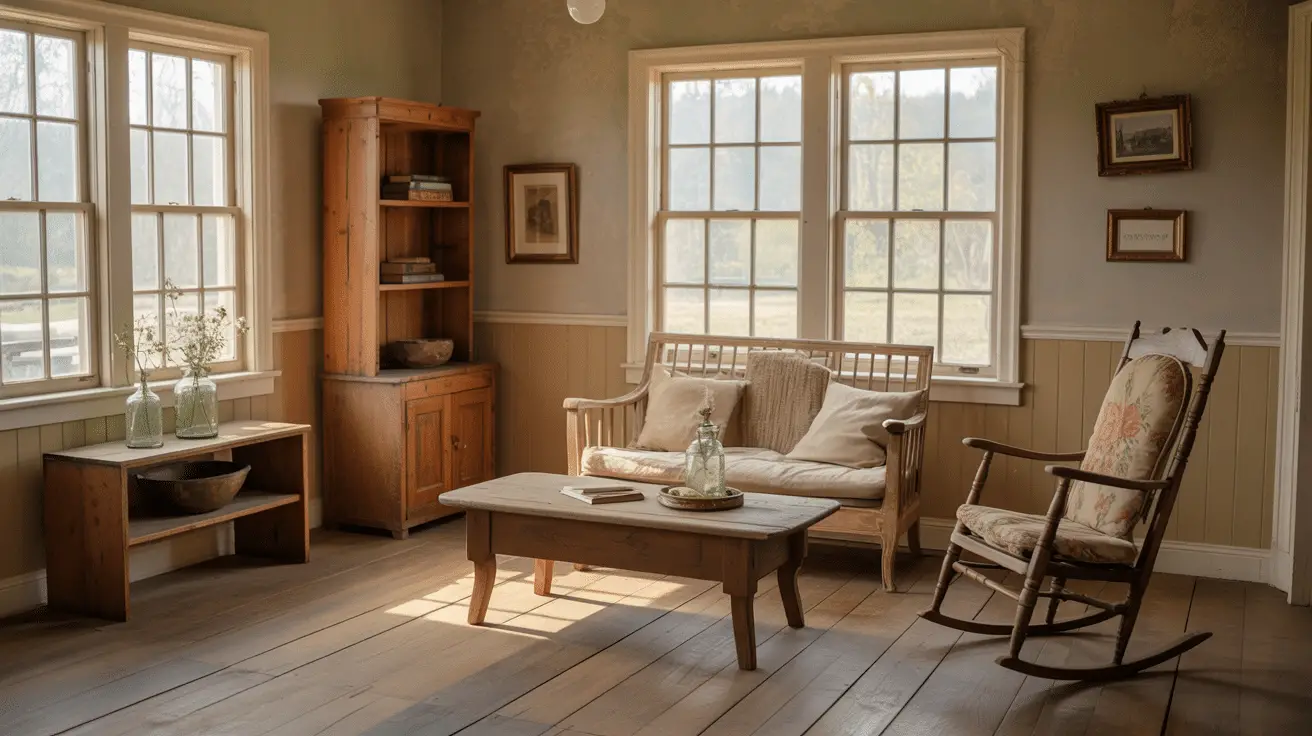Color Palettes to Elevate Your Antique Farmhouse Style: Timeless Combinations for a Cozy, Elegant Home
Table of Contents
Introduction
Imagine stepping into a home where rustic charm and elegant antique pieces come together seamlessly. The key to achieving such a warm, inviting atmosphere lies not just in the furniture, but in the color palette that ties everything together. Antique farmhouse style is all about blending the old with the new, creating a space that feels timeless and cozy while still offering a modern touch.
Choosing the right color palette is a crucial step in bringing your antique farmhouse vision to life. The hues you select not only set the tone of the room but also highlight the beauty of vintage furniture, reclaimed wood accents, and soft, natural materials. Whether you’re restoring a farmhouse or creating an antique-inspired living space, the colors you choose can make or break the ambiance.
In this post, we’ll explore the best color palettes to elevate your antique farmhouse style, from soft neutrals and earth tones to bolder accents that create focal points. We’ll also cover how to balance vintage-inspired hues with contemporary touches to make sure your space feels both timeless and fresh. Get ready to transform your home into a cozy, inviting haven with these beautiful color ideas.
Soft Neutrals: The Foundation of Antique Farmhouse Charm
Soft neutral tones are the foundation of any antique farmhouse design. These colors provide a subtle backdrop that allows vintage furniture and decor to shine. Shades like off-white, beige, light gray, and soft taupe create a sense of openness and calm while evoking a classic farmhouse feel.
To bring the space to life, pair these soft neutrals with antique wooden furniture or reclaimed pieces. A neutral base allows the natural beauty of wood, iron, and vintage textiles to take center stage. Whether you choose to paint your walls, cabinetry, or furniture, a neutral color palette ensures that your antique farmhouse style remains timeless and adaptable to changing trends.
Key Tips for Using Soft Neutrals:
- Use soft neutrals on walls and large furniture pieces to create a timeless base.
- Incorporate vintage wooden furniture to add texture and warmth to the space.
- Consider adding subtle contrast with light gray or off-white accents to create depth.
- Layer neutral textiles, such as linen curtains and cotton throws, to enhance the cozy atmosphere.
Earth Tones: Embracing Nature’s Palette for a Cozy, Rustic Feel
Earth tones are a hallmark of the antique farmhouse style, reflecting the natural elements of the countryside. Rich browns, deep greens, warm terracotta, and mustard yellow are just a few of the earthy hues that can bring warmth and character to your space. These colors evoke the essence of the outdoors and work particularly well when paired with antique furniture and vintage accessories.
Earth tones can be used in various ways to create different moods. For example, deep brown tones can be used for cabinetry or accent walls, while lighter shades of green or yellow can add a cheerful, inviting touch to pillows, rugs, and artwork. The key to using earth tones effectively is balance—use them in moderation to avoid overwhelming the space, and always pair them with neutral elements to maintain the light and airy feel of the farmhouse style.

Tips for Using Earth Tones:
- Incorporate earth tones into accent pieces like rugs, throw pillows, and curtains for a grounded, natural vibe.
- Use deeper hues like forest green or chestnut brown for furniture, cabinets, or feature walls.
- Pair earthy colors with natural materials like wood, stone, and metal to enhance the rustic appeal.
- Use lighter earth tones, such as soft beige or pale olive, to keep the space feeling open and airy.
Muted Blues and Greens: Adding Tranquility and Freshness
Muted blues and greens are often seen in antique farmhouse design because of their calming and timeless nature. These soft, natural hues can evoke a sense of tranquility and freshness, ideal for bedrooms, bathrooms, and living areas where relaxation is key. Shades like dusty blue, sage green, and mint green bring a fresh, vintage-inspired touch to the home while maintaining a sense of elegance.
These colors pair wonderfully with the rustic wood and vintage furniture typical of the farmhouse style. Muted blues and greens also work well in combination with neutral tones and earthy hues, creating a balanced and harmonious atmosphere. In spaces like a farmhouse kitchen or dining room, these colors can help create a fresh, welcoming environment.
Ideas for Using Muted Blues and Greens:
- Use muted blue or sage green for walls to create a serene and peaceful atmosphere.
- Add vintage-style blue and green ceramics, such as vases or pitchers, as decorative accents.
- Combine these colors with neutral tones like white or beige for a light and airy look.
- Consider soft green or blue cabinetry in kitchens or bathrooms for a vintage touch.
Bold Accents: Adding Personality and Contrast
While the core of antique farmhouse style is rooted in soft neutrals and earthy tones, adding bold accents can help create visual interest and personality. Rich, deep colors like navy blue, charcoal gray, and mustard yellow bring a touch of drama and sophistication to a room. These bold hues can be incorporated through accent furniture, artwork, or textiles.
For example, a mustard yellow armchair or navy blue throw pillow can serve as a striking focal point in an otherwise neutral room. Bold accents work particularly well in spaces like living rooms, where you can introduce them through smaller decor items like rugs, curtains, or lamps without overwhelming the space.
How to Use Bold Accents Effectively:
- Introduce bold colors through smaller accessories like throw pillows, curtains, and rugs.
- Use deep shades like navy blue or charcoal gray for statement furniture pieces, such as armchairs or sofas.
- Pair bold colors with neutral tones to maintain balance and prevent the space from feeling too intense.
- Choose vintage-inspired artwork or decorative pieces in bold colors to add personality to your walls.
Whites and Off-Whites: The Ultimate Timeless Base
While soft neutrals like beige and gray are commonly used, white and off-white tones are the ultimate base for an antique farmhouse space. These colors provide a clean, crisp backdrop that allows the beauty of antique furniture, artwork, and vintage accessories to shine. They also create a sense of openness and light, which is ideal for smaller spaces.
White is versatile and timeless, and it pairs beautifully with any of the other color palettes mentioned, such as earth tones or muted blues. Whether used for walls, furniture, or trim, white and off-white create a fresh, airy feel that is essential to the farmhouse aesthetic.
White and Off-White Decorating Tips:
- Use white for walls and ceilings to create a bright, open space.
- Opt for off-white or ivory furniture to add warmth without losing the freshness of white.
- Incorporate white in trim, moldings, or window frames to create a polished, cohesive look.
- Layer white with softer neutral tones and warm wood accents to create a balanced and inviting room.
Vintage-Inspired Patterns and Textures
To complement your color palette, vintage-inspired patterns and textures can elevate your antique farmhouse style. Whether it’s floral wallpaper, plaid patterns, or embroidered linens, these textures help bring depth and warmth to a space. Incorporating patterns into pillows, rugs, and curtains can also enhance the rustic, timeless vibe of your farmhouse home.
Consider using patterned rugs or throws in your living areas to introduce subtle contrast while staying true to the farmhouse aesthetic. Textures such as burlap, linen, and wool also add a cozy, rustic touch that complements your chosen color palette.
How to Incorporate Vintage Patterns and Textures:
- Use vintage floral or plaid patterns for accent pillows, throw blankets, or upholstery.
- Incorporate textured fabrics like linen, burlap, and wool for curtains, cushions, and throws.
- Mix and match subtle patterns in different areas of the room to create depth without overwhelming the space.
- Keep patterns muted and complementary to the overall color palette to maintain a cohesive look.
Conclusion
Creating the perfect color palette for your antique farmhouse home is about more than just picking pretty hues—it’s about evoking a sense of warmth, nostalgia, and timeless elegance. By choosing the right combination of soft neutrals, earthy tones, muted blues, and bold accents, you can craft a space that is both inviting and sophisticated. Whether you’re working with a vintage farmhouse or infusing an antique-inspired design into a new build, these color palettes offer a versatile foundation for any room in your home.

